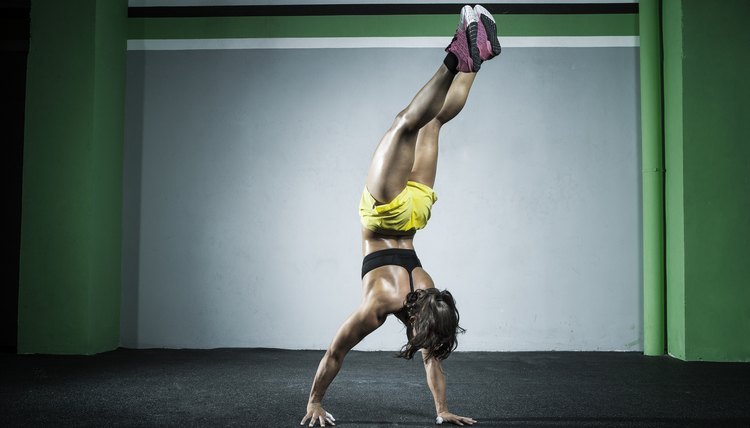What does fact checked mean?
At SportsRec, we strive to deliver objective content that is accurate and up-to-date. Our team periodically reviews articles in order to ensure content quality. The sources cited below consist of evidence from peer-reviewed journals, prominent medical organizations, academic associations, and government data.
The information contained on this site is for informational purposes only, and should not be used as a substitute for the advice of a professional health care provider. Please check with the appropriate physician regarding health questions and concerns. Although we strive to deliver accurate and up-to-date information, no guarantee to that effect is made.
Do You Have to Be Strong to Do Handstands?

You don’t need to be Hercules do a handstand, although it does require a certain level of strength. But that's just one of the requirements — you also need balance, flexibility and confidence. One more major requirement is overcoming fear, mainly the innate human fear of falling.
Required Strength
The strength you need to do a handstand comes from various muscles throughout your body. Your arms need to be strong enough to support your weight and hold the pose. Your legs need to be strong enough to kick your body weight up into the handstand position. Your back, stomach and other core muscles need to be strong enough to keep your body aligned while you hold yourself upside down.
Testing Strength
Before kicking up into a handstand, test your core strength to determine if the muscles are strong enough to hold your body straight up in the air. Lie on your back with your arms straight along your sides. Keep your body straight and flat against the floor while you tense all your muscles. Ask a friend to lift your feet about 3 feet off the floor. If you’re strong enough for a handstand, your body will still be tight and aligned, with your hips, legs and torso in the same straight line they were when on the floor.
Building Strength
You can build up the strength you need to execute a handstand, or enhance the strength you already have, with several exercises. If your body is not strong enough on its own to support a handstand, start by doing one against the wall, letting the wall support your body weight. Maintaining a handstand position gradually builds up the muscles you need. Start by staying in a handstand for at least 15 seconds and gradually increase the time by five-second intervals. Moving your hands closer to the wall as you progress helps to shift your dependency on the wall to dependency on your arm strength to maintain the pose.
Fear and Other Factors
Work on your flexibility with regular stretching exercises. Enhance your balance with balance exercises that can be as simple as standing on one leg for a sustained period. Practice can also help you overcome your fear. Falling is likely until you determine how forcefully you need to kick to propel your body into a handstand. Accepting that — and learning how to fall without injury — can help you overcome the fear. If you feel yourself toppling over, tuck your head and gently fall into a forward roll. Fully and calmly focusing on your task at hand before going into the handstand will also give you better results than trying to attempt the pose with a panicked, racing or distracted mind.
References
- “Yoga Journal” magazine: Yearning for Handstand
- Yoga Journal: From Fear to Freedom
- ACE: Stability Ball Pikes
- Miniato MA, Anand P, Varacallo M. Anatomy, Shoulder and Upper Limb, Shoulder. [Updated 2020 Jul 31]. In: StatPearls [Internet]. Treasure Island (FL): StatPearls Publishing; 2020 Jan-. Available from:
- Huxel Bliven KC, Anderson BE. Core stability training for injury prevention. Sports Health. 2013 Nov;5(6):514-22. doi: 10.1177/1941738113481200. PMID: 24427426; PMCID: PMC3806175.
- Akhtar MW, Karimi H, Gilani SA. Effectiveness of core stabilization exercises and routine exercise therapy in management of pain in chronic non-specific low back pain: A randomized controlled clinical trial. Pak J Med Sci. 2017;33(4):1002-1006. doi:10.12669/pjms.334.12664
- Han J, Waddington G, Adams R, Anson J, Liu Y. Assessing proprioception: A critical review of methods. J Sport Health Sci. 2016;5(1):80-90. doi:10.1016/j.jshs.2014.10.004
- McGowan CJ, Pyne DB, Thompson KG, Rattray B. Warm-Up Strategies for Sport and Exercise: Mechanisms and Applications. Sports Med. 2015;45(11):1523-1546. doi:10.1007/s40279-015-0376-x
- CrossFit Level One Training Guide, Second Edition. CrossFit; 2019.
- Glassman G. What Is Fitness? The CrossFit Journal. October 2002.
- The Handstand Push-Up. Demos, Scaling, Progressions, & Warmup. WODWell; 2019.
Writer Bio
Ryn Gargulinski is a writer, artist and performer whose journalism career began in 1991. Credits include two illustrated books, "Bony Yoga" and "Rats Incredible." She holds a Master of Arts in English literature and folklore and a Bachelor of Fine Arts in creative writing with a French minor from Brooklyn College.
